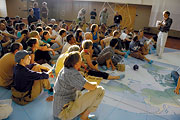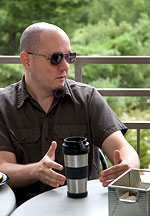
We are the world: Jim Hausman explains global interconnectedness using Buckminster Fuller’s innovative Dymaxion AirOcean World Map. photo by Mariah Grant
|
Did you know that simply by replacing your home’s incandescent bulbs with compact-fluorescent lights you can single-handedly remove hundreds of pounds of carbon from our air each year, and keep hundreds of pounds of coal from being burned by our local power plants? Or that using grass- and plant-covered “green roofs” in downtown Asheville could greatly diminish the runoff that helps create the nonpoint-source pollution threatening our watersheds?
To hear participants in the latest Design Science Lab talk, we are spiraling toward calamity — but only if we fail to act on often simple, sensible and cost-effective solutions that are literally at our fingertips. Many successful strategies are already being employed elsewhere in the world, and we can accomplish a great deal simply by accessing online information available to any curious Google monkey (see sidebar, “Brave New Ideas”).
The 2006 Design Science Lab (held July 19-28 at UNCA) was a joint project of the Buckminster Fuller Institute in New York City and the Pennsylvania-based BigPictureSmallWorld, in partnership with Global Education Motivators (a United Nations-affiliated nonprofit), the United Nations International School and our own Black Mountain College Museum + Arts Center, among others. For 10 days, 39 participants from Western North Carolina and the world at large put in long, often grueling stints with one aim: take recognizable local and global problems, break them down into their component parts, and devise real-world solutions that can be undertaken not only by governments and organizations but also by individuals.
But these incipient world-shakers aren’t done: Their next task is to help put those proposed solutions into action, both in their own lives and by helping spread the word throughout the region, including the public at large, and stakeholders in government, business, academia and pretty much any group with an interest in protecting our region.
The lab was inspired by the work of architect/scientist/inventor/philosopher Buckminster Fuller. The renegade thinker, who taught at the famed Black Mountain College, developed design science as a way to help humanity address its myriad problems. “At its core is a new way of seeing the world — one that takes a global, whole-systems perspective that incorporates a well-developed sensibility about social justice and environmental sustainability,” according to the DSL Web site.
A pretty highfalutin and amorphous-sounding concept, to be sure, but its central premise is simple: We control our own destiny.
Bringing it home

Picture this: Design Science Lab organizer David McConville lays out his vision of a sustainable future. photo by Jonathan Welch
|
This latest Design Science Lab was the first to be held outside of U.N. headquarters in New York, and much of the credit for its coming here goes to West Asheville wunderkind and Fuller acolyte David McConville (see “Astral Projector,” April 26 Xpress). The labs are based on the United Nations’ Millennium Development Goals, which address key global issues such as poverty, hunger, education and environmental sustainability, largely in underdeveloped areas of the world.
The first such assemblage, held at the United Nations last summer, tackled world hunger; another one took place there in June. But the Asheville gathering was also the first to look at problems on a regional scale, notes McConville.
And while participants did consider global educational and environmental issues, the workshops focused on local sustainability issues centering on energy, the environment and education.
“We took a holistic look at the way we use and produce energy,” explained Jonah Butcher, a renewable-energy consultant from Asheville. “I’m excited about some of the ideas that are coming out.”
At a public closing ceremony, the various working groups outlined their solutions, citing ideas that ranged from large to small. Butcher’s group, for example, recommended that the state — which regulates how much profit utilities such as Progress Energy and Duke Power can make — should give them an incentive to move toward renewable, nonpolluting energy sources. The group suggested that the state tailor profit margins to the energy source, allowing less profit during peak-demand periods for conventionally generated energy and more for renewable energy. This tactic, used successfully elsewhere, would encourage producers to ramp up their use of renewable sources such as wind and solar power, while discouraging construction of new coal-fired and nuclear plants, explained group member Dee Eggers, an assistant professor of environmental-studies at UNCA.
Smaller-scale approaches might include creating a “local hero” program that would publicly recognize people who substantially reduced their personal energy usage, said fellow lab participant Robin Cape, who serves on the Asheville City Council. Another small idea with a potentially big local impact, noted Butcher, would be to offer consumers a product that might be called energy in a box. Affordably priced, the box would contain caulk and a caulking gun, compact-fluorescent lights, a power strip and household energy-conservation tips. The group calculated that using these items would save the average household $193 annually.
“We [spent] a lot of time focusing on the present and the preferred state and how to get there,” said Cape, explaining how her group had approached its work. “Right now, energy efficiency in homes is an incredibly big wedge on our production of energy, and we’re all starting to know that. What are we doing to make a dramatic impact in a relatively focused amount of time? What we’re looking at is sort of a combination program that can be supported by business and carried out by volunteers and incentivized through local publicity, like ‘Do you want to be a local hero?’ for climate protection.” The other key component, notes Cape, is to “give people the tools they need.”
In the coming weeks, the Design Science Lab’s solutions will be fleshed out and formalized. But the real challenge, McConville told Xpress, is to avoid having the conclusions become just one more report that sits on a shelf.
“The real challenge in taking the Design Science Lab to the local level is that the people involved actually have to make sure they know how to do it themselves” and are willing to work to make their proposed solutions a reality, rather than relying on the city or some other group, he said.
One impediment to change is that people often have a hard time imagining the invisible, said McConville, whose group looked at local education. Accordingly, the group plans to develop and make available visualization tools, using various forms of art and electronic media.
What about those incandescent bulbs in your home, for instance? By using them, each household creates about 900 pounds of carbon dioxide per year, says McConville. “What does [that] look like?” he asks. And answering his own question, McConville continues: “That’s an abstraction, because that 900 pounds doesn’t really look like anything. If you replace a couple of light bulbs with compact fluorescents, [that’s what you’ll save].
“If you can visualize that and show people this is what the impact will be on your environment and then, by taking this 900 pounds of carbon dioxide out of your environment, it will stop the biosphere from deteriorating this much more, you can connect those dots and help people understand the full system more intuitively. My experience is that people are always much more likely to act if they understand themselves as part of the system.”
Getting people to act, he emphasizes, is the whole point. To that end, the proposed solutions will be made available in book form as soon as possible, and a special Web page will be available soon at www.bigpicturesmallworld.com through a special Asheville Design Science Lab link, said company founder Medard Gabel. The site will feature details on all the strategies that came out of the lab — including how individuals, groups, businesses and governments can contribute to achieving sustainability in the region.
And if any city can put these ideas into action, it’s Asheville, according to Elizabeth Thompson, executive director of the Buckminster Fuller Institute. Addressing lab participants and those who attended the public unveiling of the results, Thompson often had to compose herself, fighting back tears as she bid the lab and the city adieu.
“What we’ve shared here is the incredible work that an incredibly inspired collection of individuals have committed to do on behalf of their homes, their families, their communities,” she said. “I want to thank you all for welcoming us to Asheville: You are an incredible place.”


Before you comment
The comments section is here to provide a platform for civil dialogue on the issues we face together as a local community. Xpress is committed to offering this platform for all voices, but when the tone of the discussion gets nasty or strays off topic, we believe many people choose not to participate. Xpress editors are determined to moderate comments to ensure a constructive interchange is maintained. All comments judged not to be in keeping with the spirit of civil discourse will be removed and repeat violators will be banned. See here for our terms of service. Thank you for being part of this effort to promote respectful discussion.